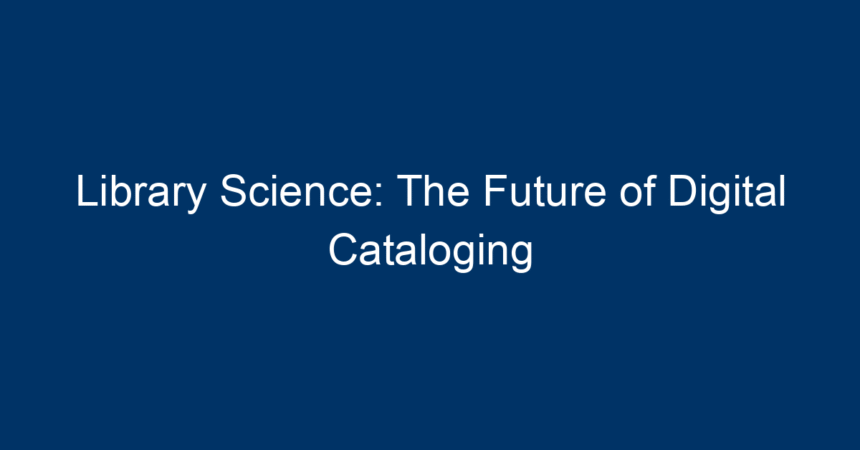Introduction
In an age where information is at our fingertips, the relevance of traditional library structures is evolving rapidly. Library science, a discipline focused on the organization, management, and dissemination of information, is experiencing a digital transformation that shapes how libraries function. Digital cataloging—the process of managing bibliographic data using electronic tools—anchors this transition. By embracing innovative technologies and methodologies, library science can better meet the needs of modern users, ensuring that libraries remain vital information hubs in our increasingly digital world.
The Historical Context of Library Science
Evolution of Cataloging
Library science has undergone significant transformations since the first libraries emerged. The advent of the printed book in the late 15th century initiated changes in how information was stored and cataloged. As libraries grew, so did the complexity of cataloging systems, leading to the development of classification systems like the Dewey Decimal System and the Library of Congress Classification.
The introduction of computers in the latter half of the 20th century marked a pivotal shift. Digital cataloging emerged as a way to streamline the cataloging process. This digital revolution laid the groundwork for what we now recognize as modern library science.
The Shift to Digital Cataloging
What is Digital Cataloging?
Digital cataloging refers to the use of computerized systems to create, manage, and maintain bibliographic records. It allows libraries to build searchable databases, replacing card catalogs with user-friendly interfaces. This shift has made accessing information faster, more efficient, and accessible from various devices.
Advantages of Digital Cataloging
-
Efficiency: Digital cataloging significantly reduces the time required for data entry and retrieval. Automated processes allow for quick updates and modifications, enabling librarians to focus on user services rather than administrative tasks.
-
Accessibility: Digital records can be accessed globally, allowing users to retrieve information from anywhere. This promotes equal access to information, fulfilling the democratic role of libraries in society.
-
Improved User Experience: Advanced search functionalities enable users to locate materials quickly and accurately, enhancing the overall user experience. Features like tags, filters, and user-generated lists make exploring library resources more intuitive.
- Integration of Multimedia: Digital cataloging supports various media formats, including text, audio, video, and images. This flexibility allows libraries to curate a diverse range of materials, catering to different learning styles and preferences.
Current Trends in Library Science and Digital Cataloging
1. Metadata Standards
In library science, metadata refers to data that provides information about other data. Enhanced metadata standards, such as Dublin Core and MARC (Machine-Readable Cataloging), help libraries create richer catalog entries, facilitating better search results. The emphasis on structured and standardized metadata allows interoperability across different databases and platforms.
2. Linked Data and Semantic Web Technologies
Linked data allows libraries to publish and connect information on the web in a way that machines can understand. This approach enhances cataloging practices, enabling better integration of library resources with external data sources. The semantic web, focusing on making web content understandable to machines, further enhances this capability, allowing for more intelligent information retrieval systems.
3. User-Centric Design
As library science evolves, user-centric design becomes increasingly crucial. Libraries are focusing on understanding user needs through surveys, analytics, and feedback. Digital cataloging systems are being designed to reflect these insights, ensuring that users can interact with catalogs in ways that are most beneficial to them.
4. Artificial Intelligence and Machine Learning
Artificial intelligence (AI) and machine learning are making waves in the field of library science. From automated cataloging processes to predictive analytics that assess user behavior, AI is shaping how libraries manage their collections. Machine learning algorithms can also improve search algorithms, ensuring users find relevant materials faster.
Challenges of Digital Cataloging
1. Digital Literacy
While digital cataloging offers numerous advantages, disparities in digital literacy can pose challenges. Not all users are equally proficient with technology, and librarians must take steps to provide support and training to ensure everyone can access digital resources.
2. Data Privacy and Security
With the increasing reliance on digital systems, privacy concerns are paramount. Libraries must navigate complex regulations concerning data protection while implementing robust security measures to safeguard user information.
3. The Digital Divide
The issue of the digital divide—where certain populations have limited access to technology—remains a concern. While online resources vastly improve accessibility for many, librarians must continue to advocate for equitable access to ensure that everyone can benefit from digital cataloging advancements.
The Role of Library Professionals in the Digital Age
Lifelong Learning
Library professionals must adopt a mindset of lifelong learning to keep pace with technological advancements within library science. Continuous training in digital tools, data management, and emerging trends is essential for effective cataloging and outreach.
Collaboration
Collaboration among library professionals, technology experts, and community stakeholders is vital for successful digital cataloging initiatives. By working together, libraries can share resources, develop innovative solutions, and advocate for the needs of their communities.
Advocacy
Library professionals play a crucial role in advocating for digital literacy programs and equitable access to technology. By promoting awareness of digital cataloging’s benefits and addressing its challenges, librarians can empower users and foster community engagement.
Future Directions for Library Science and Digital Cataloging
Embracing Open Access
The open access movement advocates for the free availability of scholarly works. Libraries can lead the charge in promoting and implementing open access models. By employing digital cataloging techniques, libraries can help disseminate knowledge widely without paywalls.
Enhancing Community Engagement
Future digital cataloging initiatives should prioritize community engagement. Libraries can host workshops, webinars, and events that highlight the digital resources available, encouraging users to explore and utilize those tools.
Leveraging Social Media
Social media platforms are powerful tools for increasing library visibility and outreach. Libraries can use these platforms to promote digital catalogs, share tips on how to navigate them, and engage with users in meaningful ways.
Conclusion
As the future of library science unfolds, digital cataloging will continuously evolve, shaping how libraries function in the digital landscape. By embracing innovative technologies, focusing on user experience, and addressing challenges proactively, libraries can remain essential community resources.
To harness the power of digital cataloging effectively, library professionals must prioritize continuous learning, collaboration, and advocacy. These actionable steps ensure that libraries not only adapt to change but thrive in it, empowering users and enriching communities worldwide. Embrace the future of library science: a digital cataloging revolution awaits!




